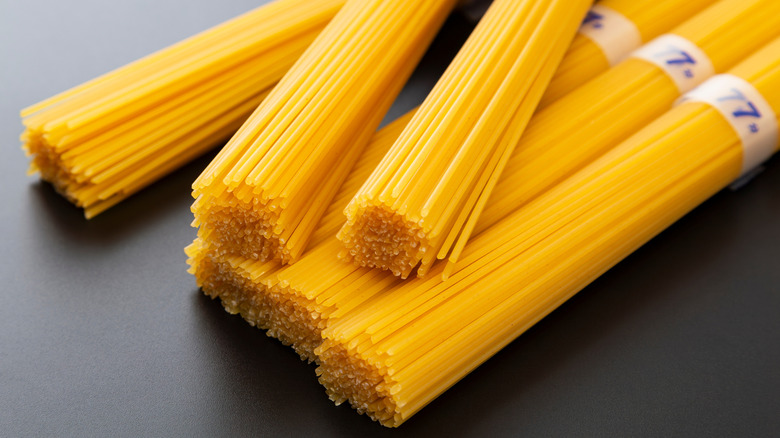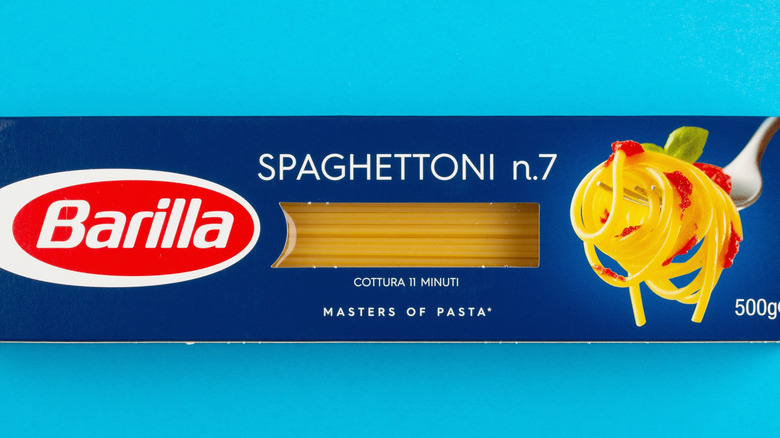The Subtle Difference Between Spaghetti, Spaghettini And Spaghettoni Pasta
Spaghetti is a staple of Italian cuisine, and, by adoption, Italian-American cuisine. The long, thin, cylindrical pasta is considered a favorite pasta shape by millions for a variety of reasons. For one, the lengthy noodles are fun to twirl around a fork to eat (don't cut it, that's a spaghetti etiquette faux pas!). Secondly, the dishes we use the pasta in have become beloved classics: Spaghetti and meatballs, bolognese, and carbonara, to name a few. But did you know that there are different varieties of the noodle? Spaghetti, spaghettini, and spaghettoni are three distinct types of long pasta whose discrepancies come down to their width.
You are probably familiar with the width of a classic spaghetti noodle. It's not as thick as a cord, but not as thin as a string. The substantial yet skinny long noodles are perfect for smooth sauces that err on the side of thin so as not to weigh the noodles down or interfere with their ability to be fork-spun. Marinara is a go-to, as is pesto or a simple mix of olive oil, garlic, and red pepper flakes. These sauces are substantial enough to stick to the noodles, but aren't too creamy, heavy, or chunky.
Tini, as in spaghettini, is a suffix indicating smallness
The lesser-known spaghettini is a thinner version of its cousin. This pasta shape is reminiscent of string — it's thicker than capellini (angel hair) or vermicelli but noticeably thinner than spaghetti. It's still cylindrical and long, but its delicate smaller width comes in handy for different dishes than the thicker version. Don't forget that it will cook quicker than spaghetti, and if you're going for an authentic al dente texture, you'll need to keep an eye on it.
Similar to angel hair, spaghettini noodles are often used for light, thin, oil-based, or seafood sauces. A butter-based white wine and tomato lobster sauce would work well for the stringy noodles, as would the creamy sauce that goes with this lemony shrimp scampi ravioli recipe. One thing to keep in mind about spaghettini is that, because they are thinner, there is less space in each noodle to absorb water when boiling, so they can become more dry; that's why thin, wet sauces are preferred for serving. These noodles are also perfect to star in soups or broths. Try them in pho or ramen for an Asian-Italian fusion dinner.
Spaghettoni, spaghetti's big brother
We've covered spaghetti's thinner relative, so you won't be shocked to hear that spaghettoni is the thicker version, roughly the width of cord rather than string. It's still long and round but more substantial and, well, cord-like. The larger diameter of these noodles means there is more surface area in each, making them easier to fork.
These noodles are better carriers for chunky sauces; thinner noodles don't hold the bits and pieces as easily, so they tend to fall off the fork when scooped. Spaghettoni is a great pasta choice for the creamy sauce and porky bites of carbonara and the tomato-based version, amatriciana. The same goes for bolognese; these noodles will ensure every bite is equally full of pasta, meat, veggie bits, and sauce. In Italy, even fatter and flatter tagliatelle is the traditional pasta for a ragu — or bolognese — sauce.
Now that you know the differences between the pastas, you can better choose the shape that best suits your dish. Many pasta brands give a number to each particular variety of pasta, but annoyingly the numbers aren't the same on each brand — however, the smaller the number, the thinner the pasta as a general rule. You may struggle to find spaghettini and spaghettoni in grocery stores, but they can be found easily online. Try Pastificio Bragagnolo's spaghettoni for an Italian-made option, and Garofalo's spaghettini is available in bulk, so you're never short if skinny is your preferred shape.


